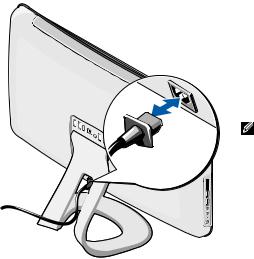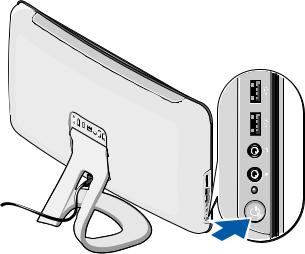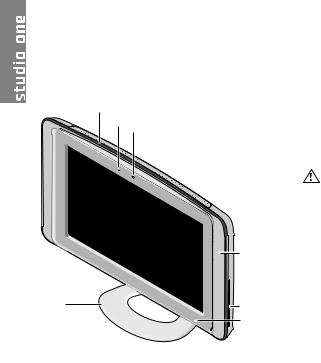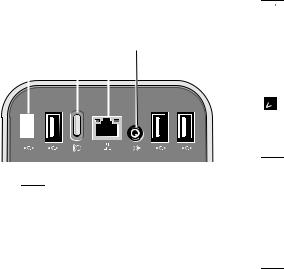Dell Studio One 19 User Manual

SETUP GUIDE


SETUP GUIDE
Model MTF

Notes, Cautions, and Warnings
 NOTE: A NOTE indicates important information that helps you make better use of your computer.
NOTE: A NOTE indicates important information that helps you make better use of your computer.
CAUTION: A CAUTION indicates either potential damage to hardware or loss of data and tells you how to avoid the problem.
 WARNING: A WARNING indicates a potential for property damage, personal injury, or death.
WARNING: A WARNING indicates a potential for property damage, personal injury, or death.
__________________
Information in this document is subject to change without notice. © 2009 Dell Inc. All rights reserved.
Reproduction of these materials in any manner whatsoever without the written permission of Dell Inc. is strictly forbidden.
Trademarks used in this text: Dell, the DELL logo, and YOURS IS HERE are trademarks of Dell Inc.; Intel and Celeron are registered trademarks and Core is a trademark of Intel Corporation in the United States and other countries; Microsoft, Windows, Windows Vista, and Windows Vista start button logo are either trademarks or registered trademarks of Microsoft Corporation in the United States and/or other countries; Blu-ray Disc is a trademark of the Blu-ray Disc Association; Bluetooth is a registered trademark owned by Bluetooth SIG, Inc. and is used by Dell under license.
Other trademarks and trade names may be used in this document to refer to either the entities claiming the marks and names or their products. Dell Inc. disclaims any proprietary interest in trademarks and trade names other than its own.
September 2009 P/N P687X Rev. A01
Contents
Setting Up Your Studio One 5
Before Setting Up Your Computer |
5 |
Connect the Network Cable (Optional) |
6 |
Connect the Power Cable |
7 |
Set Up the Wireless Keyboard and |
|
Mouse (Optional) |
7 |
Press the Power Button |
8 |
Windows Vista® Setup |
9 |
Connect to the Internet (Optional) |
9 |
Using Your Studio One 12
Front View Features 12 Left Side Features 14 Back Panel Features 16 Locating the Service Tag 17 Using the Optical Disc Drive 17
Using the Touch Screen (Optional) 18 Software Features 21
Solving Problems 23
Touch Screen Problems 23
Wireless Keyboard or Mouse
Problems 24 Network Problems 25 Power Problems 26 Memory Problems 27 Lockups and Software Problems 27
Using Support Tools 30
Dell Support Center 30 Beep Codes 30 System Messages 31
3
Contents |
|
|
|
Hardware Troubleshooter |
32 |
Finding More Information and |
|
Dell Diagnostics |
33 |
Resources |
46 |
|
|
||
System Recovery Options |
35 |
Specifications |
48 |
|
|
||
System Restore |
35 |
Appendix |
53 |
Dell Factory Image Restore |
36 |
Macrovision Product Notice |
53 |
Operating System Reinstallation |
38 |
Index |
54 |
Getting Help 40
Technical Support and Customer
Service 41
DellConnect 41
Online Services 41
Automated Order-Status Service 42
Returning Items for Repair Under
Warranty or for Credit 42
Before You Call 43
Contacting Dell 44
4

Setting Up Your Studio One
This section provides information about setting up your Studio One and connecting peripherals.
WARNING: Before you begin any of the
procedures in this section, read the safety information that shipped with your computer. For additional safety best practices information, see the Regulatory
Compliance Homepage at www.dell.com/ regulatory_compliance.
Before Setting Up Your Computer
When positioning your computer, ensure that you allow easy access to a power source, controls and connections on the left side, adequate ventilation, and a stable level surface to place your computer.
Restricting airflow around your Studio One may cause it to overheat. To prevent
overheating ensure that you leave a minimum of 5.1 cm (2 inches) on all the sides. You should never place your computer in an enclosed space, such as a cabinet when it is powered on.
5

Setting Up Your Studio One
Connect the Network Cable
(Optional)
6
A network connection is not required to complete this computer setup, but if you have an existing network or Internet connection that uses a cable connection (such as a home
cable modem or Ethernet jack), you can connect it now.
Use only an Ethernet cable (RJ45 connector). Do not plug a telephone cable (RJ11 connector) into the network connector.
To attach your computer to a network or broadband device, connect one end of a network cable to either a network port or a broadband device. Connect the other end of the network cable to the network adapter connector on the back panel of your computer. A click indicates that the network cable has been securely attached.

|
Setting Up Your Studio One |
Connect the Power Cable |
Set Up the Wireless Keyboard and |
|
Mouse (Optional) |
|
Your Studio One supports a special wireless |
|
(non-Bluetooth) keyboard and mouse which are |
|
optimized for use with your computer. |
|
After installing the batteries the wireless |
|
keyboard and mouse are synced and ready |
|
to use. If you have a problem setting up your |
|
wireless keyboard and mouse, see “Wireless |
|
Keyboard or Mouse Problems” on page 24. |
|
NOTE: The wireless keyboard and mouse |
|
have special features which may not be |
|
available on other devices that could be |
|
used with your computer. |
7

Setting Up Your Studio One
Press the Power Button
8

Windows Vista® Setup
Your Dell computer is pre configured with Windows Vista. To set up Windows Vista for the first time, follow the instructions on the screen. These steps are mandatory and may take some time to complete. The screens will take you through several procedures including accepting license agreements, setting preferences, and setting up an Internet connection.
CAUTION: Do not interrupt the operating system’s setup process. Doing so may render your computer unusable.
Setting Up Your Studio One
Connect to the Internet (Optional)
 NOTE: ISPs and ISP offerings vary by country.
NOTE: ISPs and ISP offerings vary by country.
To connect to the Internet, you need an external modem or network connection and an Internet service provider (ISP). Your ISP will offer one or more of the following Internet connection options:
•DSL connections that provide high-speed Internet access through your existing telephone line or cellular telephone service. With a DSL connection, you can access the Internet and use your telephone on the same line simultaneously.
•Cable modem connections that provide high speed Internet access through your local cable TV line.
•Satellite modem connections that provide high-speed Internet access through a satellite television system.
9

Setting Up Your Studio One
•Dial-up connections that provide Internet access through a telephone line. Dialup connections are considerably slower than DSL and cable (or satellite) modem
connections. Your computer does not have an integrated modem. An optional USB modem must be used for dial-up service with this computer.
•Wireless LAN connections that provide Internet access using WiFi 802.11 technology. Wireless LAN support requires optional internal components that may or may not be installed in your computer based on decisions made at the time of purchase.
 NOTE: If an external USB modem or WLAN adapter is not part of your original order you can purchase one from the Dell website at dell.com.
NOTE: If an external USB modem or WLAN adapter is not part of your original order you can purchase one from the Dell website at dell.com.
10
Setting Up a Wired Connection
•If you are using a dial-up connection, connect the telephone line to the external USB modem (optional) and to the telephone wall jack before you set up your Internet connection.
•If you are using a DSL or cable/satellite modem connection, contact your ISP or cellular telephone service for setup instructions.
To complete setting up your wired internet connection, follow the instructions in “Setting Up Your Internet Connection” on page 11.
Setting Up a Wireless Connection
 NOTE: To set up your wireless router, see the documentation that shipped with your router.
NOTE: To set up your wireless router, see the documentation that shipped with your router.
Before you can use your wireless Internet connection, you need to connect to your wireless router. To set up your connection to a wireless router:

1.Save and close any open files, and exit any open programs.
2.Click Start  → Connect To.
→ Connect To.
3.Follow the instructions on the screen to complete the setup.
Setting Up Your Internet Connection
If you do not have an ISP icon on your desktop or if you want to set up an Internet connection with a different ISP, perform the steps in the following section.
 NOTE: If you cannot connect to the Internet but have successfully connected in the past, the ISP might have a service outage. Contact your ISP to check the service status, or try connecting again later.
NOTE: If you cannot connect to the Internet but have successfully connected in the past, the ISP might have a service outage. Contact your ISP to check the service status, or try connecting again later.
 NOTE: Have your ISP information ready. If you do not have an ISP, the Connect to the Internet wizard can help you get one.
NOTE: Have your ISP information ready. If you do not have an ISP, the Connect to the Internet wizard can help you get one.
1.Save and close any open files, and exit any open programs.
Setting Up Your Studio One
2.Click Start  → Control Panel.
→ Control Panel.
3.Under Network and Internet, click Connect to the Internet.
The Connect to the Internet window appears.
4.Click either Broadband (PPPoE) or Dial-up, depending on how you want to connect:
•Choose Broadband if you will use a DSL, satellite modem, cable TV modem, or Bluetooth® wireless technology connection.
•Chose Dial-up if you will use an optional USB dial-up modem or ISDN.
 NOTE: If you do not know which type of connection to select, click Help me choose or contact your ISP.
NOTE: If you do not know which type of connection to select, click Help me choose or contact your ISP.
Follow the instructions on the screen and use the setup information provided by your ISP to complete the setup.
11

Using Your Studio One
Front View Features
1
2 3
|
4 |
7 |
5 |
|
6 |
1Air vents — Internal fans create airflow through the vents to prevent the computer from overheating. The fans are turned on automatically when the computer gets hot. Fan noise is normal and does not indicate a problem with the fan or the computer.
WARNING: Ensure that none of the computer air vents are blocked. Blocking the vents will cause serious thermal problems.
2Camera activity light (optional) —
Indicates if the camera is on or off.
12

3Camera/microphone (optional) — Built-in camera and microphone array for video capture, conferencing, and chat.
4Speakers (2)
5Optical drive — Plays or records only standard-size (12 cm) CDs and DVDs. See “Using the Optical Disc Drive” on page 17 for more information.
6

 Optical drive eject control — Lights up when the computer starts up and when a disc is in the optical drive. To eject a disc gently touch the control.
Optical drive eject control — Lights up when the computer starts up and when a disc is in the optical drive. To eject a disc gently touch the control.
Using Your Studio One
7Computer stand — Use the stand to tilt the display to your preferred angle. It can be tilted up to 40°. The stand provides stability to the computer; it is not a removable part.
WARNING: The computer stand should remain installed at all times to ensure maximum system stability.
 NOTE: Your computer Service Tag/ Express Service Code is located on a label under the display glass. To view the Service Tag/Express Service Code tilt the display by 40°. Use this code when you access the Dell Support website or contact technical support.
NOTE: Your computer Service Tag/ Express Service Code is located on a label under the display glass. To view the Service Tag/Express Service Code tilt the display by 40°. Use this code when you access the Dell Support website or contact technical support.
13

Using Your Studio One
Left Side Features
 1
1

 2
2
3

 4
4

 5
5
6
14
1 Media Card Reader — Provides a fast and convenient way to view and share digital photos, music, videos, and
Media Card Reader — Provides a fast and convenient way to view and share digital photos, music, videos, and
documents stored on the following digital memory cards:
•Secure digital (SD) memory card
•Multi Media Card (MMC)
•Memory Stick
•Memory Stick PRO
•xD-Picture Card (type - M and type - H)
•Hi Speed-SD
•Hi Density -SD
2

 USB 2.0 connectors (2) — Connects to USB devices, such as a mouse, keyboard, printer, external drive, or
USB 2.0 connectors (2) — Connects to USB devices, such as a mouse, keyboard, printer, external drive, or
MP3 player.

|
|
|
|
|
|
|
|
Using Your Studio One |
3 |
|
|
|
Headphone or line-out connector — |
6 |
|
|
Power button and light — Turns the |
|
|
|
|
|
||||
|
|
|
|
|||||
|
Connects to headphones. |
|
computer on or off when pressed. The |
|||||
|
|
|
NOTE: To connect to a powered |
|
light in the center of this button indicates |
|||
|
|
|
|
|||||
|
|
|
|
the power state: |
||||
|
|
|
speaker or sound system, use the line |
|
||||
|
|
|
out connector on the back of your |
|
• Solid amber — the computer is in sleep |
|||
|
|
|
computer. |
|
|
state |
||
4 |
|
|
|
Microphone or line-in connector — |
|
|
OR |
|
|
|
|
|
|||||
|
|
|
|
|
the system board cannot start |
|||
|
Connects to a microphone for voice or to |
|
|
|||||
|
|
|
initialization. There may be an issue |
|||||
|
an audio cable for audio. |
|
|
|||||
|
|
|
with either the system board or the |
|||||
5 Hard drive activity light — Turns on |
|
|
||||||
|
|
power supply. |
||||||
|
when the computer reads or writes data. |
|
|
|||||
|
|
• Solid white — the computer is in |
||||||
|
A flashing light indicates hard drive |
|
||||||
|
|
|
power-on state. |
|||||
|
activity. |
|
|
|||||
|
|
• Blinking amber — there is a |
||||||
|
|
|
CAUTION: To avoid loss of data, |
|
||||
|
|
|
|
|
power problem, a device may be |
|||
|
|
|
never turn off the computer while the |
|
|
|||
|
|
|
|
|
malfunctioning or incorrectly installed. |
|||
|
|
|
hard drive activity light is flashing. |
|
|
|
|
|
15

Using Your Studio One
Back Panel Features
1 |
2 |
3 |
4 |
||||
|
|
|
|
|
|
|
|
|
|
|
|
|
|
|
|
|
|
|
|
|
|
|
|
|
|
|
|
|
|
|
|
|
|
|
|
|
|
|
|
|
|
|
|
|
|
|
|
1

 USB 2.0 connectors (4) — Connects to USB devices, such as a mouse, keyboard, printer, external drive, or MP3 player.
USB 2.0 connectors (4) — Connects to USB devices, such as a mouse, keyboard, printer, external drive, or MP3 player.
16
2


 Wireless sync button —
Wireless sync button —
Reestablishes the connection between your computer, mouse, and keyboard. To use, press the sync button on the back of your computer, then on the device that you wish to reconnect.
 NOTE: The wireless sync button is functional only if you purchase a wireless keyboard and mouse along with your computer.
NOTE: The wireless sync button is functional only if you purchase a wireless keyboard and mouse along with your computer.
3

 Network connector and light —
Network connector and light —
Connects your computer to a network or broadband device. The network activity light flashes when the computer is transmitting or receiving data. A high volume of network traffic may make this light appear to be in a steady “on” state.
4

 Line-out connector — Connects to a powered speaker or sound system.
Line-out connector — Connects to a powered speaker or sound system.

Using Your Studio One
Locating the Service Tag |
Using the Optical Disc Drive |
 1
1
1 Service Tag
Gently tilt the display upwards to reveal the Service Tag.
Insert the disc, with the label facing outwards and gently push the disc into the slot. The drive will automatically pull the disc in and begin reading its content. To eject a disc from the drive, gently touch the eject control.
17
